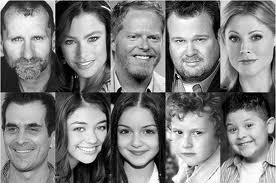I found this week’s MODERN FAMILY (“Strangers on a Treadmill”) to be a good example of how bare bones a “story” can be, and still have a beginning, middle and end. (Or, if you will, three dramatic acts of Setup, Complications, Resolution.)
Spoiler alert if you read on…
In one story, Claire is concerned Phil will embarrass herself with his unfunny jokes when hosting an upcoming realtors banquet. (1) She hears the jokes, and hides her concern (ACT ONE, INCITING EVENT); (2) She asks Mitchell to tell Phil the truth, in exchange for her telling Cameron he shouldn’t wear bike shorts; (3) Mitchell can’t bring himself to do it; (4) Claire freaks out on Mitchell over it (I would call these three scenes the SECOND ACT in a three-act structure); so (5) Claire hides Phil’s notes at the banquet – which results in him improvising, surprising everyone with being funny anyway; after which (6) She admits to hiding the cards, and they make up (THIRD ACT). Note: Claire is the main character, because she’s the one with the PROBLEM, and it’s seen through her POINT-OF-VIEW, not through Phil’s. Phil doesn’t have a problem initially, at least not that he’s aware of. Claire is the one with a situation that needs to be solved.
In the second story, (1) Mitchell is concerned about Cameron wearing bike shorts, but can’t tell him because Cameron is so sensitive (ACT ONE, INCITING EVENT). (2) He makes a deal with Claire as described above (in the same Scene 2 of the first story). (3) Claire does the job and Cameron is devastated. (4) Cameron finds out Mitchell was behind this (in the same Scene 4 of the first story – happens during a phone call between Claire and Mitchell); (5) Cameron and Mitchell make up, after Mitchell is willing to shave his beard to please Cameron (THIRD ACT). Again, Mitchell is the main character of this storyline, as he’s the one with the PROBLEM, which is how to tell Cameron not to wear bike shorts. (In contrast to a few weeks ago, when Cameron was the main character of a story about how Mitchell is dangerous with power tools but thinks he’s handy, and how do you stop him from causing damage without hurting his feelings?)
The other two stories are less developed. The first lays out like this: (1) Jay doesn’t know his employees well enough, in Gloria’s mind, so he agrees to go to one of their daughters’ quinceanera, where (2) he befriends people who Gloria realizes aren’t his employees, because they’re at the wrong event which is actually a wedding (a couple scenes of this in the middle act), which resolves with (3) Jay freaking out when the supposed father and daughter (really a married couple) make out on the dance floor, and Gloria tells him the truth. Main character: Jay, who has the problem of Gloria accusing him, and something to prove.
Finally, we have (1) Haley observing that Alex is too servile on the phone with a popular girl at school; (2) Haley gives her advice on how to be more cool with the girl, and forces her to follow it; (3) Haley later sees Alex has mastered this, to her shock and gratification; only to have (4) It all get messed up and Haley returns to her old, too-eager-to-please self. Main character: Haley, concerned about her sister being uncool and wanting to fix it. To her, it’s a problem (though not to Alex, initially).
Not every half-hour show has four storylines in an episode, but this is an example of one that manages to serve each with a limited number of scenes: as little as one scene each for the first and last act, and 2-3 brief scenes in the second act. Note that in every case, we return to the normal status quo at the end of the episode, one which may not be deliriously happy (Jay still an aloof boss, Alex still uncool, etc.), but with the crisis that set off the story of the week now resolved…


Thanks for the analysis of Modern Family, I love that show! Four story lines in a half-hour show, they have really well defined characters, IMO, to be able to do that!